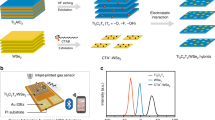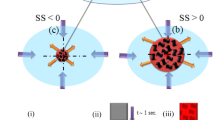Abstract
There is a great demand for the reliable and quantitative detection of NO2 to monitor and control environmental pollution and subsequently prevent harmful human health effects. Metal oxide-based chemiresistive sensors detect this notorious gas, but high operating temperatures (100–500 °C) limit their applicability. Organic polymers can perform room-temperature sensing, but such sensors are rare due to the lack of functional groups needed for effective analyte detection and discrimination. This paper describes the selective sensing of NO2 gas by incorporating well-defined N-heteroatom functionalization into organic polymers. Three structurally analogous novel one-dimensional tetrazine polymers (p-phenyl-, m-phenyl- and thienyl-substituted) were synthesized in this study. Incorporating such π units allows the polymers to be stabilized in their partially oxidized forms, resulting in various ratios of dihydrotetrazine (0–55%):tetrazine units in the polymer backbone. All of the synthesized polymers were tested as resistive sensors for NO2. The polymer pPTz, possessing the highest dihydrotetrazine (~55%) content, exhibited the best performance for detecting 25–150 ppm NO2 compared to the other two polymers (mPTz, TTz). The pPTz-based sensor was found to be fast, taking 115 s to respond to 150 ppm NO2, reversible with a recovery time of 560 s for 150 ppm NO2 and could sense NO2 at room temperature. pPTz was also found to be highly selective for NO2 over the other tested analytes, such as NH3, EtOH, MeOH, acetone, 2-nitro toluene, and humidity. Synergetic interactions arising from –NH hydrogen bonding (dihydrotetrazine) and the N-heteroatom (tetrazine) functionalities in pPTz were expected to be the reason for the superior and selective detection of NO2. The structure-property relationship studies reported in this work may pave the way for designing functional conducting polymers for excellent chemiresistive sensing.
This is a preview of subscription content, access via your institution
Access options
Subscribe to this journal
Receive 12 print issues and online access
$259.00 per year
only $21.58 per issue
Buy this article
- Purchase on Springer Link
- Instant access to full article PDF
Prices may be subject to local taxes which are calculated during checkout









Similar content being viewed by others
References
Luttrell WE. Nitrogen dioxide. J Chem Heal Saf. 2014;21:28–30.
Manisalidis I, Stavropoulou E, Stavropoulos A, Bezirtzoglou E. Environmental and health impacts of air pollution: a review. Front Public Heal. 2020;8:1–13.
Kasuga, H Health effects of air pollution. How to conquer air Pollut. a Japanese Exp. 95–113 (1989).
Environmental Protection Agency (EPA). Nitrogen oxides (NOx), why and how they are controlled. Epa-456/F-99-006R 48 (1999).
Wöllenstein, J, Peter, C, Schmitt, K, Courbat, J & Briand, D D3.3 - Colorimetric gas sensors for the detection of am¬monia, nitrogen dioxide and carbon monoxide: Current Status and Research Trends. 135–135 (2020).
Schmitt K, Tarantik K, Pannek C, Sulz G, Wöllenstein J. Colorimetric gas sensing with enhanced sensitivity. Procedia Eng. 2016;168:1237–40.
Di Francia G, Alfano B, La Ferrara V. Conductometric gas nanosensors. J Sensors. 2009;2009:659275.
Pasierb P, Rekas M. Solid-state potentiometric gas sensors-current status and future trends. J Solid State Electrochem. 2009;13:3–25.
Wong YC, Ang BC, Haseeb ASMA, Baharuddin AA, Wong YH. Review—conducting polymers as chemiresistive gas sensing materials: a review. J Electrochem Soc 2020;167:037503.
Yu SH, Girma HG, Sim KM, Yoon S, Park JM, Kong H, et al. Polymer-based flexible NOx sensors with ppb-level detection at room temperature using breath-figure molding. Nanoscale. 2019;11:17709–17.
Yuvaraja S, Surya SG, Chernikova V, Vijjapu MT, Shekhah O, Bhatt PM, et al. Realization of an ultrasensitive and highly selective OFET NO2 sensor: the synergistic combination of PDVT-10 polymer and porphyrin − MOF. ACS Appl Mater Interfaces 2020;12:18748–60.
Srinivasan P, Ezhilan M, Kulandaisamy AJ, Babu KJ, Rayappan JBB. Room temperature chemiresistive gas sensors: challenges and strategies—a mini review. J Mater Sci Mater Electron. 2019;30:15825–47.
Santra S, Hu G, Howe RCT, De Luca A, Ali SZ, Udrea F, et al. CMOS integration of inkjet-printed graphene for humidity sensing. Sci Rep. 2015;5:1–12.
Depari A, De Marcellis A, Ferri G, Flammini A. A complementary metal oxide semiconductor - Integrable conditioning circuit for resistive chemical sensor management. Meas Sci Technol. 2011;22:124001.
Fine GF, Cavanagh LM, Afonja A, Binions R. Metal oxide semi-conductor gas sensors in environmental monitoring. Sensors. 2010;10:5469–502.
Kanan SM, El-Kadri OM, Abu-Yousef IA, Kanan MC. Semiconducting metal oxide based sensors for selective gas pollutant detection. Sensors. 2009;9:8158–96.
Ghosh R, Gardner JW, Guha PK. Air pollution monitoring using near room temperature resistive gas sensors: a review. IEEE Trans Electron Devices. 2019;66:3254–64.
Zhang Y, Jiang Y, Duan Z, Huang Q, Wu Y, Liu B, et al. Highly sensitive and selective NO2 sensor of alkalized V2CTx MXene driven by interlayer swelling. Sens Actuators B Chem. 2021;344:130150.
Liu B, Liu X, Yuan Z, Jiang Y, Su Y, Ma J, et al. A flexible NO2 gas sensor based on polypyrrole/nitrogen-doped multiwall carbon nanotube operating at room temperature. Sensors Actuators B Chem. 2019;295:86–92.
Tang R, Shi Y, Hou Z, Wei L. Carbon nanotube-based chemiresistive sensors. Sensors. 2017;17:882.
Wang F, Gu H, Swager TM. Carbon nanotube/polythiophene chemiresistive sensors for chemical warfare agents. J Am Chem Soc. 2008;130:5392–3.
Fratoddi I, Venditti I, Cametti C, Russo MV. Chemiresistive polyaniline-based gas sensors: A mini review. Sensors Actuators B Chem. 2015;220:534–48.
Pandey S. Highly sensitive and selective chemiresistor gas/vapor sensors based on polyaniline nanocomposite: a comprehensive review. J Sci Adv Mater Devices. 2016;1:431–53.
dos Reis MAL, Thomazi F, del Nero J, Roman LS. Development of a chemiresistor sensor based on polymers-dye blend for detection of ethanol vapor. Sensors. 2010;10:2812–20.
Kwon OS, Park SJ, Yoon H, Jang J. Highly sensitive and selective chemiresistive sensors based on multidimensional polypyrrole nanotubes. Chem Commun. 2012;48:10526–8.
Wu D, Sedgwick AC, Gunnlaugsson T, Akkaya EU, Yoon J, James TD. Fluorescent chemosensors: The past, present and future. Chem Soc Rev. 2017;46:7105–23.
Liu B, Zhuang J, Wei G. Recent advances in the design of colorimetric sensors for environmental monitoring. Environ Sci Nano. 2020;7:2195–213.
Zhao Q, He Z, Jiang Y, Yuan Z, Wu H, Su C, et al. Enhanced acetone-sensing properties of PEI thin film by GO-NH2 functional groups modification at room temperature. Front Mater. 2019;5:1–5.
Bekyarova E, Davis M, Burch T, Itkis ME, Zhao B, Sunshine S, et al. Chemically functionalized single-walled carbon nanotubes as ammonia sensors. J Phys Chem B. 2004;108:19717–20.
Abel SB, Olejnik R, Rivarola CR, Slobodian P, Saha P, Acevedo DF, et al. Resistive sensors for organic vapors based on nanostructured and chemically modified polyanilines. IEEE Sens J. 2018;18:6510–6.
Cavallo P, Frontera E, Acevedo DF, Olejnik R, Slobodian P, Saha P, et al. Functionalized polyanilines made by nucleophilic addition reaction, applied in gas sensors field. Synth Met. 2016;215:127–33.
Yoon B, Choi SJ, Swager TM, Walsh GF. Flexible chemiresistive cyclohexanone sensors based on single-walled carbon nanotube-polymer composites. ACS Sens. 2021;6:3056–62.
Yoon B, Choi SJ, Swager TM, Walsh GF. Switchable single-walled carbon nanotube-polymer composites for CO2 sensing. ACS Appl Mater Interfaces. 2018;10:33373–9.
Yang K, Yuan W, Hua Z, Tang Y, Yin F, Xia D. Triazine-based two-dimensional organic polymer for selective NO2 sensing with excellent performance. ACS Appl Mater Interfaces. 2020;12:3919–27.
Tao LM, Niu F, Zhang D, Wang TM, Wang QH. Amorphous covalent triazine frameworks for high performance room temperature ammonia gas sensing. N J Chem 2014;38:2774–7.
Ko WC, Kim MS, Kwon YJ, Jeong J, Kim WR, Choi H, et al. Two-dimensional semiconducting covalent organic nanosheets for highly sensitive and stable NO2sensing under humid conditions. J Mater Chem A. 2020;8:19246–53.
Srinivasan P, Samanta S, Krishnakumar A, Rayappan JBB, Kailasam K. Insights into g-C3N4as a chemi-resistive gas sensor for VOCs and humidity-a review of the state of the art and recent advancements. J Mater Chem A. 2021;9:10612–51.
Sharma N, Sharma N, Srinivasan P, Kumar S, Balaguru Rayappan JB, Kailasam K. Heptazine based organic framework as a chemiresistive sensor for ammonia detection at room temperature. J Mater Chem A. 2018;6:18389–95.
Niu F, Shao ZW, Zhu JL, Tao LM, Ding Y. Structural evolution of imine-linked covalent organic frameworks and their NH3sensing performance. J Mater Chem C. 2021;9:8562–9.
Quinton C, Chi SH, Dumas-Verdes C, Audebert P, Clavier G, Perry JW, et al. Novel s-tetrazine-based dyes with enhanced two-photon absorption cross-section. J Mater Chem C. 2015;3:8351–7.
Joshi S, Raj KA, Rao MR, Ghosh R. An electronic biosensor based on semiconducting tetrazine polymer immobilizing matrix coated on rGO for carcinoembryonic antigen. Sci Rep. 2022;12:1–14.
Kulkarni S, Ghosh R. A simple approach for sensing and accurate prediction of multiple organic vapors by sensors based on CuO nanowires. Sensors Actuators. B Chem. 2021;335:129701.
Acknowledgements
RRM thanks the Science and Engineering Research Board (SERB), India, for partially supporting this research through its Early Career Research Award Scheme (ECR/2018/002285) and IIT Dharwad for the seed grant. RG acknowledges the Council of Scientific and Industrial Research (CSIR), India, for supporting this work partially through Extramural Research Grant (22(0787)/19/EMR-II). We are grateful to the Sophisticated Central Instrumentation Facility (SCIF), IIT Dharwad, and its staff members for assisting us with the material characterizations. We also thank the University Scientific and Instruments Center (USIC), Karnataka University Dharwad; Instrumentation facility, Department of Chemistry, IIT Bombay for assisting with material characterization.
Author information
Authors and Affiliations
Corresponding author
Ethics declarations
Conflict of interest
The authors declare no competing interests.
Additional information
Publisher’s note Springer Nature remains neutral with regard to jurisdictional claims in published maps and institutional affiliations.
Supplementary information
41428_2022_667_MOESM1_ESM.docx
Tetrazine based 1D-Polymers for Selective Chemiresistive Sensing of Nitrogen Dioxide via Interplay of Hydrogen bonding and N-heteroatom interactions
Rights and permissions
About this article
Cite this article
K, A.R., Gorthala, G., Ghosh, R. et al. Tetrazine-based 1D polymers for the selective chemiresistive sensing of nitrogen dioxide via the interplay between hydrogen bonding and n-heteroatom interactions. Polym J 54, 1191–1201 (2022). https://doi.org/10.1038/s41428-022-00667-3
Received:
Revised:
Accepted:
Published:
Issue Date:
DOI: https://doi.org/10.1038/s41428-022-00667-3



